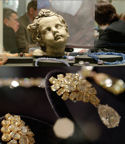Living the Life of Luxury
March 31, 08
There are some trade shows that pride themselves on their size, there are some that emphasize their international reach and there are others that boast about the business they create. But now there’s another type of show in the exhibition lexicology – the luxury show.
There is no denying that Baselworld epitomises the highest standards and sumptuousness of the trade show world. With booths big enough that they ought to be rented out as a solution to the accommodation crunch that hits the area during the show and stands that are beautiful enough to get their own write up in Architectural Digest, Baselworld is a show that emphasizes its European je ne sais qoui.
The one thing that Basel, and other shows, doesn’t have is intimacy. The many halls of Baseworld scream numbers, people, traffic, more and more every year in a bid to outdo the previous show. But that’s about to change. It seems, or at least show organizers are hedging their bets on the fact that exhibitors and attendees are sick and tired of being part of the thronging masses. Attendees are done with schlepping miles and miles between each appointment, and exhibitors are tired of visitors that don’t translate into buyers. New shows are hitting the exhibition calendar that are downsizing in terms of numbers but upping their standards in terms of luxury.
Of course, this is nothing new. The Centurion Show, which takes place in Tucson each year, is a well-known invitation-only show. Another example of the smaller format came in 2007 when a group of companies that had previously exhibited at the Couture show in Las Vegas broke away to form Premier, an exclusive, appointment-driven show. And it is a format that seemed to work, with participants expressing satisfaction about the intimate nature of the show and the ability it gave them to really get down to business.
Outside of America, 2008 is the year of two new and very different invitation-only trade events: IIJS Goa in India and About J in Italy.
Anyone who has ever attended the IIJS show in Mumbai knows that there is nothing luxurious about the event. Typically taking place right in monsoon season, the show grounds have been known to flood, water drips in alarmingly and while the food is some of the best served at a trade show, the other facilities are basic at best. In an attempt to move away from these infrastructure problems, which are in no way the fault of the Gem and Jewellery Export and Promotion Council (GJEPC), the show organizers, GJEPC this year decided to hold an additional show in the paradise beach state of Goa, India.
The business-to-business, invitation-only jewelry event, which took place at the end of February featured a select group of exhibitors and buyers and was one of GJEPC’s attempts to open the Indian market to more foreign companies rather than just regional attendees of the sort that attend the Mumbai show. 
Image Courtesy of
MCH Messe Schweiz
According to GJEPC, the aim of the event was to meet the sourcing needs of jewelers with global operations. They claimed that with only 1,500 to 2,000 buyers and around 150 to 200 exhibitors, attendees would be able to get the time and the attention that is often lacking from the bigger shows.
Dolly Satpathy, GJEPC assistant director of promotion, marketing and business development said that GJEPC hand-picked exhibitors and buyers in order to create a “premium show.”
According to the show organizers, “Buyers will come away with a new show experience – in ambience, hospitality and style, while finding just the merchandise they need.” Those companies that were invited to attend were those dealing in fine or couture jewelry, gold jewelry, “bread and butter jewelry” (as long as it is cutting edge) and companies with unique and exclusive designs and innovation, craftsmanship and finish.
Visitors to the show were mainly foreign retailers, though the top 100 Indian retailers also received a special invitation to attend.
The About Jewelry show, organized by the Vicenza Fair, which was billed as “The Ultimate Jewellery Event,” was due to take place in Milan at the beginning of March. Coming at the tail end of Milan Fashion Week, this event was not conceived as an average trade show. For a start, it was designed to be small, with only 60 Italian and 20 international brands invited to attend. Attendee numbers were also purposely low – 150 buyers and 350 Italian high-end retail outlets.
For international buyers, organizers provided full board hospitality including flights, transfers, hotel accommodation, food and entertainment. The show was mainly targeting buyers from Central and Eastern Europe, central Asia, the Middle East, the Caribbean and the U.S. – very different from the traditional idea of a trade fair.
It seems that while the uber-shows need not fear for their existence just yet, they may find themselves losing ground to their smaller, more luxurious competitors. Only time will tell.